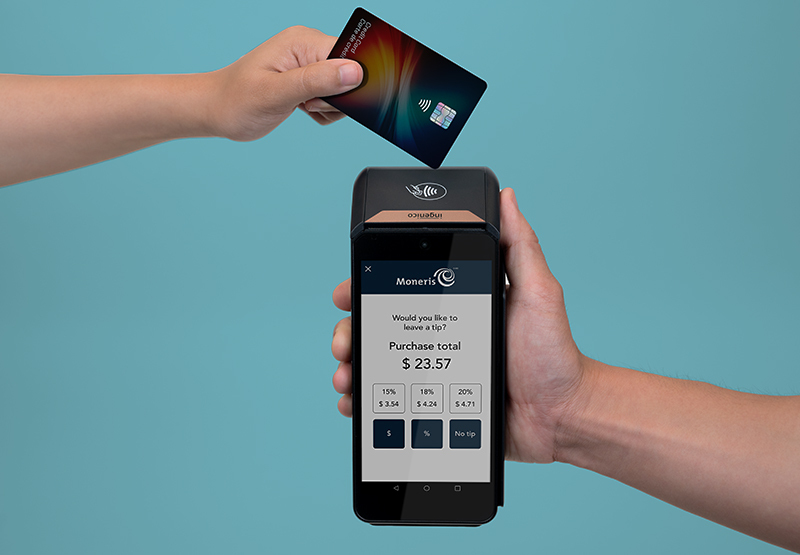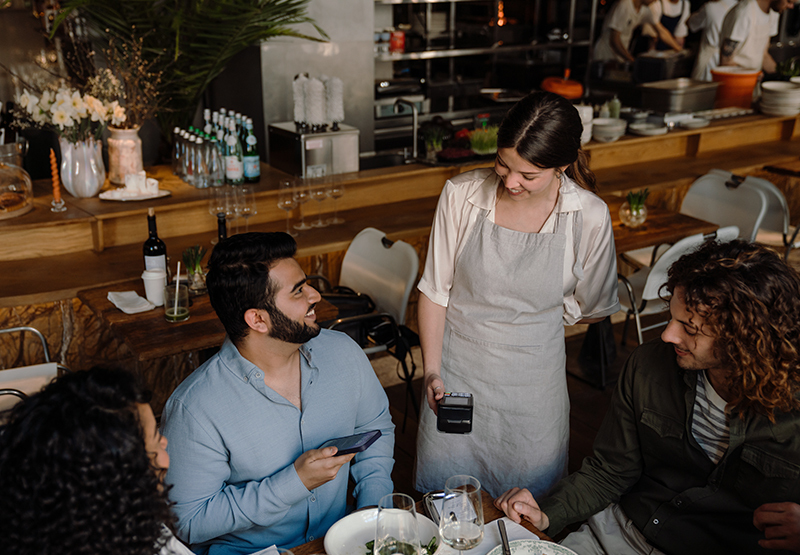Tipping is deeply ingrained in Canadian culture and etiquette. While not legally required, it is a strong social norm and an expected practice in many service industries to show appreciation for exceptional customer service. As a business owner, you can facilitate tipping by providing convenient options on your payment terminals. Exceptional service is what typically drives higher tips in Canada's tipping culture.
To learn more about the Canadian tipping etiquette and when it is acceptable to ask your customers for a tip, we sat down with Jordan Williamson, Vice President of Core Products and Strategy at Moneris.

This blog includes:
How has the tipping culture in Canada evolved over the years
Impact of the pandemic on the tipping culture in Canada
General guidelines or etiquette for business owners when it comes to tipping
Importance of transparent pricing
Factors to consider when determining tipping policies
Potential benefits of implementing a tipping policy
How to review your tip settings on your payment device
How has the tipping culture in Canada evolved over the years?
Jordan- Tipping is largely a North American concept. The origin of tipping was for exceptional service. About 10 years ago, it was mainly only restaurants that turned on tips on the terminals. Now even low-touch service providers have turned on tip prompts. Turning on tips today when they didn't in the past and those presets going from the old standards of 10-15% to 20% or higher. It is quite rare to see a device prompt for a 10% tip today.
How do you think the pandemic has impacted the tipping culture in Canada?
Jordan- I think the pandemic definitely increased tipping culture. Some of our data shows that tipping went up and tipping added to other industries outside of where you already tipped. Places where people wouldn't have tipped in the past, they became more giving. This speaks to the caring and positive nature of people.
I feel that those not financially impacted by the pandemic felt responsible for helping the community. Many were okay to give a tip for curbside pickup to appreciate those working during the pandemic. Some of the markets have adjusted back to how it was before the pandemic, but I do think some of it lingers.
Can you share some general guidelines or etiquette for business owners when it comes to tipping?
Jordan- You can look at this from two perspectives. One is the business owner’s perspective and one from the customer’s perspective. For the business owner, they’re looking for opportunities for their staff to receive additional recognition through compensation for exceptional work. From the customer’s perspective they're paying for a product or service.
There's an agreed upon price and depending on the industry, that tipping screen could be viewed as either something expected or something unexpected. So, that's something the business owner should be conscious of because if it's not expected then it could be viewed with a negative sentiment.
Let's say you're in an industry that traditionally has a tipping culture, for example, a restaurant, then you have a lot more leniency on how you manage the tip handling. If you're in some sort of retail environment, you could be catching people off guard by asking for a tip.
What, according to you, are the dos and don’ts of tipping from a business owners’ perspective?
Jordan- Dos and don'ts are highly conditional, based on your industry. Of course, no one knows your business better than you do. However, with that said, there are norms when it comes to tipping.
Say you run a restaurant on the East Coast, a 25% tip on the terminal is very uncommon there. It’s important to align with the norms in your geographic region and industry verticals. If you believe that there's a reason to break those rules and prompt for something significantly more, then make sure that your service justifies it.
How can business owners ensure fairness and transparency in their tipping practices amongst their staff and customers?
Jordan- Let’s take the example of a restaurant. The server might be the one who receives the tip from the from the customer, but we know that the host was the one that sat at the table and dropped off menus, introduced the special or gave some recommendations. The server came back over to take the order. A busser cleared the table throughout the dinner. The bartender was the one that prepared the fancy drinks. So, overall, it’s a team effort.
A lot of businesses do some sort of tip pool where it might not be 100% for one person. A percentage or a dollar value of tips would end up being shared with the host or the bartender. Most receivers of tips understand the value that all those other positions bring to the guest experience and are happy to do some tip share. Restaurant owners can keep such factors in mind, making sure that it's fair and transparent to their staff of how the distribution was done in a fair manner.
For customers, I think businesses should look at how they treat every customer and their level of service to ensure their service is up to par. Also, disclosure is important. If there was something like a surcharge on a transaction that a merchant is choosing to implement, Moneris terminals enforce a prompt that to the cardholders so that they can see and they can accept it. When there's a foreign currency exchange, our terminals tell the cardholder what the exchange rate is so they can make an informed decision. So, disclosure is crucial.
What factors should business owners consider when determining their tipping policies?
Jordan- Whether it's tipping or anything else, you should know your market well. That's how you're going to be a successful business. At Moneris, our market is Canada. So, we try to know Canada inside and out. We try to know everything from payments to vertical solutions, value added services, all inside and out. We want to know what our competition is doing and what they're not doing so that we can figure out what's best.
Say you’re running a restaurant, you’d want to scope out restaurants in your area, and analyze how does your price point compare to theirs. You want to ask yourself; how does my offering align to theirs? How do my hours of operations compare to theirs? How have I set up tips on my device? If you are different from the competition, make sure you understand why. That goes with tipping or anything else. If you're aligning nicely, you should feel secure in what you're doing right.
What are the potential benefits for businesses in implementing a tipping policy?
Jordan- The main benefit is for the employees. Tipping is a recognition of performance that allows your employees to be able to be recognized by the customers for that exceptional service and that could lead to better employee retention.
What are the most important things you think merchants should know about managing tipping or using Moneris products best in this manner?
Jordan- There is a lot of flexibility on the Moneris devices. On the Moneris Go family of devices, you can set a preset either by a dollar amount or a percentage on the tipping screen.
For example, in the restaurant industry tip presets by percentage are commonplace, however in other services like a barbershop or nail salon it may be more appropriate to set presets by dollar amount.
What do you foresee for the future of tipping in businesses?
Jordan- I have two predictions and we'll see which one is right. And they're opposites to each other. One is that we will continue to see the proliferation of tipping and we will see it pop up in non-traditional places increasingly going forward. I read a news article recently where an unattended kiosk prompted a tip.
But then the opposite to that is another article I read which was showing the negative light of tipping and saying that it was an issue with the current culture in North America. So, with that we could see public pushback. Especially as the economic forces are tightening. A lot of the tipping culture in the restaurant industry came from low wages, specifically in the US market which was offset by tips. As the service industry continues to increase wages, we might see the public push it back on tipping culture.
How to review your tip settings on your Moneris Go device
After learning more about the tipping culture in Canada, you may wish to review and change the tip settings in your Moneris Go device. To do so:
On the Tips Settings screen, you can customize how customers leave tips. Review the options and take one of these actions:
To Accept Default Settings-
Tap Save to keep the shown settings and move forward. You can change them later.
To Change Settings-
Tips: Toggle on to allow customers to leave tips. This will show tip options.
Tip by Dollar and Tip by Percentage: Toggle on to let customers tip by dollar amount or percentage of the total.
Tip Pre-set Type: Choose if you want pre-set tips to be dollar values or percentages.
Tip Pre-sets 1-3: Toggle on each pre-set you want to offer. Tap the field and enter either a dollar amount or percentage, then tap the checkmark.
Once you've reviewed and changed any settings, tap Save to proceed.
Your settings will automatically sync across your Moneris Go devices. For other Moneris terminals and devices, please review your user manual, easily located online via our support section.
It’s great that you’ve made it so far. Here are some of the more common tipping practices in Canada:
- For sit-down service, the standard tip ranges from 15-20% of the total bill before taxes. A 15% tip is considered a baseline for satisfactory service, while 18-20% is for exceptional service.1
- When dining or drinking at bars, a tip of 15-20% on the total pre-tax bill is customary for table service.2
- Hairstylists and barbers generally receive a 15% tip on the total bill.1
- For food delivery drivers, about 10% tip on the total bill before taxes and fees is customary.1
We hope you now have all the information you need to set up tipping prompts for your business and help your employees earn recognition for the exceptional service they provide your customers.
Article filed under:
EducationShare



